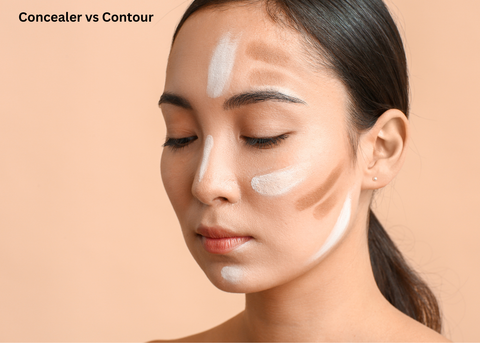
Concealer vs Contour: When and How to Use Each
A polished makeup look often comes down to how well you use two key tools: concealer and contour. These products may sit side by side in your vanity, but they do completely different things. Knowing when to reach for which can change the way your face reads in photos, under daylight, or during long events.
Let’s walk through how to get the most out of each, especially if you’re figuring out contouring for beginners or updating your base routine.
What’s the Real Difference Between Concealer and Contour?
Both work to define your face, but the goal is opposite.
Concealer is used to correct, brighten, and cover. It hides dark circles, blemishes, and uneven skin tone. Think of it as the touch-up pen that lifts tired areas and fades out imperfections.
Contour is about depth. It shapes and sculpts your features. Strategic placement of a darker tone creates the illusion of shadows. It gives more structure to your cheekbones, jawlines, and noses.
While concealer highlights, contour adds dimension.
How to Use Concealer the Right Way
A good concealer should blend smoothly, offer coverage that feels weightless, and help brighten without making the skin look flat or cakey. Use it to:
- Cover dark circles by applying in an inverted triangle under the eyes.
- Camouflage redness around the nose, chin, and forehead.
- Spot-treat blemishes using a small brush or your ring finger.
The Get Even Concealer is lightweight and infused with niacinamide, vitamin C, and bakuchiol, so it treats pigmentation and improves skin texture over time.
For under-eye use, the Eye Light Concealer works well. It’s packed with caffeine and peptides, which reduce puffiness and smooth fine lines. It’s ideal for tired eyes that need a boost.
Blemish-prone? The Zit Quit Concealer targets spots with 2% salicylic acid while still delivering feather-light coverage.
How to Use Contour for a Natural Sculpt
A good contour works with your face shape, not against it. Choose a formula that blends effortlessly and matches your undertone. If you’re just getting started with makeup contouring, the trick is to follow your natural bone structure.
Here’s where to apply:
- Under the cheekbones to create lift.
- Along the jawline to sharpen.
- On the sides of the nose for a slimming effect.
- Around the forehead to reduce width or add warmth.
Use a cream-based formula for a natural finish, or a powder contour if you’re layering over a matte base.
For an easy starting point, go with the best contour stick that’s blendable and doesn’t dry down too fast. This gives you enough time to work it in with a brush or damp sponge.
When to Apply Concealer and Contour in Your Routine
In most routines, concealer goes on after foundation and before contour. That’s when you’ve already evened out the base and can clearly see where shadows and highlights naturally fall.
Once concealer is set, contour steps in to bring back structure to the face.
Can You Use Concealer as Contour?
Only if the concealer is the right shade! Which is 3 to 4 shades darker than your skin tone and cool or neutral in tone. But a formula designed for coverage may not blend the same way a contour does. The textures often differ. Contour products are made to mimic shadows, so they blend differently on purpose.
Still, in a pinch, contouring with a darker concealer works, as long as it’s not too thick or oily.
Blending Concealer and Contour Together
To avoid harsh lines or patchiness, blend in small, circular motions. Use a damp sponge for concealer under the eyes and a dense brush for contour on the cheeks and jawline. Never blend both with the same tool. This can result in a muddy finish!
Give your concealer a few seconds to settle before blending, especially under the eyes. Let your contour set in place before you diffuse the edges. The goal is seamless transition, not visible product buildup.
Key Takeaways
- Concealer brightens and covers, while contour defines and sculpts.
- Use a shade lighter for concealer and darker for contour.
- Blend well using separate tools for each product.
- Apply concealer before contour for the most balanced finish.
- The best results come from pairing good formulas with correct placement.
FAQs
Q1. What is the difference between concealer and contour?
Concealer hides imperfections and brightens areas. Contour adds shadow and defines structure.
Q2. Can you use concealer as contour?
Only if the concealer is 3–4 shades darker and blends easily.
Q3. Do you apply concealer before or after contour?
Always apply concealer first. Contour should go on top of an even base.
Q4. What are the best products for contouring?
Look for cream or stick formulas that blend easily and match your undertone. Cooler tones look more natural.
Q5. How do you blend concealer and contour together?
Use separate tools and blend each product by following the natural shape of your face in light, circular motions.

Comments (0)
There are no comments for this article. Be the first one to leave a message!